Herbert Hoover Presidential Library & Museum
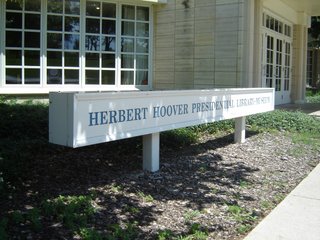 Today I made a long drive from Des Moines to West Branch, IA to see the Herbert Hoover Presidential Library & Museum. Hoover was Iowa's only President. Other than the fact that Hoover has a dam and a public interest group named after him, I knew very little about the 31st President of the United States.
Today I made a long drive from Des Moines to West Branch, IA to see the Herbert Hoover Presidential Library & Museum. Hoover was Iowa's only President. Other than the fact that Hoover has a dam and a public interest group named after him, I knew very little about the 31st President of the United States. With a $6 price of admission, this is the cheapest of the Presidential libraries I've been to, which include FDR's, Truman's, Johnson's, Carter's, and Reagan's.
With a $6 price of admission, this is the cheapest of the Presidential libraries I've been to, which include FDR's, Truman's, Johnson's, Carter's, and Reagan's. The Museum would cover his life and times. Herbert Hoover began with relatively humble beginnings, being the son of a blacksmith and businessman.
The Museum would cover his life and times. Herbert Hoover began with relatively humble beginnings, being the son of a blacksmith and businessman.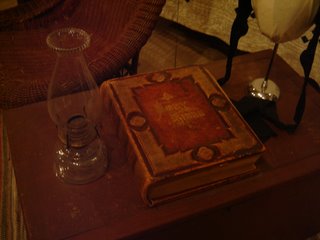 Both of Hoover's parents would die when he was a very young man. He would go on to live with his Aunt Millie and Uncle Allan Hoover on a farm near this location. Raised in the Quaker tradition, Hoover would read this Bible on a daily basis.
Both of Hoover's parents would die when he was a very young man. He would go on to live with his Aunt Millie and Uncle Allan Hoover on a farm near this location. Raised in the Quaker tradition, Hoover would read this Bible on a daily basis. Hoover would move to Oregon when he was 11 to live with his uncle, Dr. Henry John Minthorn.
Hoover would move to Oregon when he was 11 to live with his uncle, Dr. Henry John Minthorn. He eventually went to Stanford University in Palo Alto, joining the school's first class. He graduated in 1895 with a degree in geology and without any job prospects. Eventually, he got a job in the California gold mines shoveling ore in Nevada City.
He eventually went to Stanford University in Palo Alto, joining the school's first class. He graduated in 1895 with a degree in geology and without any job prospects. Eventually, he got a job in the California gold mines shoveling ore in Nevada City. He became a mining engineer and that took him to some interesting locations, like Australia in 1897, a job in which he lied about his age to get. He would be very successful at this job, eventually getting a raise to $10,000 a year!
He became a mining engineer and that took him to some interesting locations, like Australia in 1897, a job in which he lied about his age to get. He would be very successful at this job, eventually getting a raise to $10,000 a year!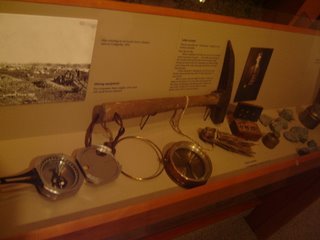 Mining equipment from this time period is on display.
Mining equipment from this time period is on display. On February 10, 1899, Hoover married Lou Henry, whom he had met at Stanford. Before you think that Hoover was a really liberal guy, Lou was a woman (an impressive one too, she was the first one to graduate from the school with a geology degree). Artifacts from the wedding are on display.
On February 10, 1899, Hoover married Lou Henry, whom he had met at Stanford. Before you think that Hoover was a really liberal guy, Lou was a woman (an impressive one too, she was the first one to graduate from the school with a geology degree). Artifacts from the wedding are on display.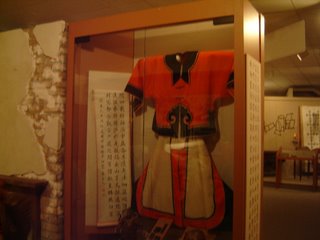 They left immediately for China, where Hoover continued his career. In 1900, they survived the Boxer Rebellion, an uprising of Chinese nationalists calling itself "I Ho Tuan". Hoover's village, Tientsen, eventually became under siege, as bullets flew near their home.
They left immediately for China, where Hoover continued his career. In 1900, they survived the Boxer Rebellion, an uprising of Chinese nationalists calling itself "I Ho Tuan". Hoover's village, Tientsen, eventually became under siege, as bullets flew near their home. At one point, an artillery shell hit their dwelling place (fragments of that shell are on display above). Shortly thereafter, Lou Hoover would read her own obituary. Eventually, U.S. Marines would rescue the Hoovers and other Americans nearby.
At one point, an artillery shell hit their dwelling place (fragments of that shell are on display above). Shortly thereafter, Lou Hoover would read her own obituary. Eventually, U.S. Marines would rescue the Hoovers and other Americans nearby.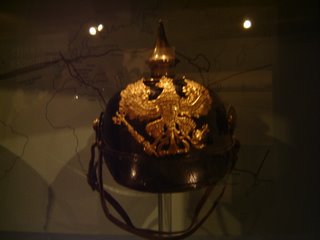 Hoover became a partner in Bewick, Moreing and Co. in 1901. He would travel the globe with his job, and made a considerable amount of money. Hoover retired from the company in 1908 and established his own international firm of engineering consultants based in London. This German pin helmet is an example of the places he saw and the cultures he interacted with.
Hoover became a partner in Bewick, Moreing and Co. in 1901. He would travel the globe with his job, and made a considerable amount of money. Hoover retired from the company in 1908 and established his own international firm of engineering consultants based in London. This German pin helmet is an example of the places he saw and the cultures he interacted with.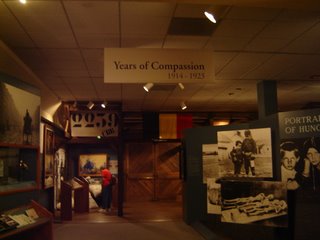 Around 1914, war was brewing and international affairs became more complicated and violent. As a self-made millionaire by age 40, Hoover was in a unique position to help. Having been raised in the Quaker tradition, he is said to have believed in being "humane and generous to others". His life would change considerably at this time.
Around 1914, war was brewing and international affairs became more complicated and violent. As a self-made millionaire by age 40, Hoover was in a unique position to help. Having been raised in the Quaker tradition, he is said to have believed in being "humane and generous to others". His life would change considerably at this time.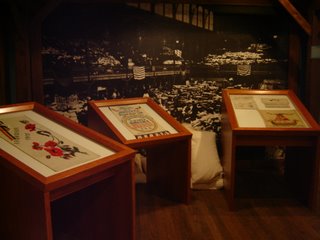 Around this time he began to help Americans stranded in Europe after the breakout of World War I and served as Chairman of Commission for Relief in Belgium, a country dependent on 80% of its food from imports that was then surrounded by British and German forces.
Around this time he began to help Americans stranded in Europe after the breakout of World War I and served as Chairman of Commission for Relief in Belgium, a country dependent on 80% of its food from imports that was then surrounded by British and German forces.In 1917, he came the United States Food Administrator for President Wilson. From 1918-19, he founded the Hoover Institution of War, Revolution, and Peace at Stanford University. It was a think tank dedicated to political affairs.
 In 1919 he would attend the Versailles Peace Conference and have a life mask made of him. It's probably the oddest exhibit of any presidential library. The treaty worked out so well everyone decided to fight again a generation later.
In 1919 he would attend the Versailles Peace Conference and have a life mask made of him. It's probably the oddest exhibit of any presidential library. The treaty worked out so well everyone decided to fight again a generation later.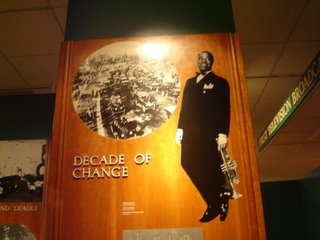 The roaring twenties would take place, and the country transformed. The museum has a section on it.
The roaring twenties would take place, and the country transformed. The museum has a section on it.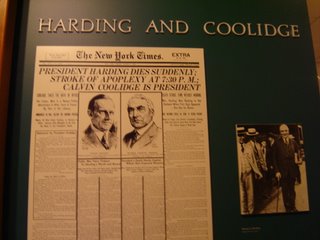 From 1921-28, he served as Secretary of Commerce for Presidents Warren G. Harding and Calvin Coolidge.
From 1921-28, he served as Secretary of Commerce for Presidents Warren G. Harding and Calvin Coolidge.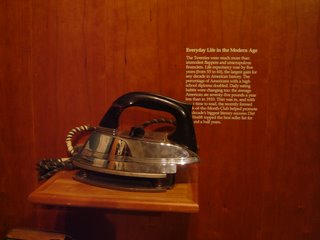 Conveniences like irons became commonplace.
Conveniences like irons became commonplace.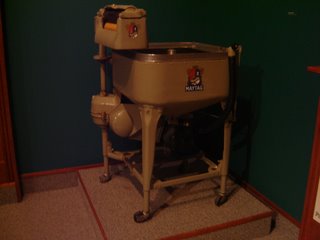 Washing machines! No more washing your clothes in the nearby river!
Washing machines! No more washing your clothes in the nearby river!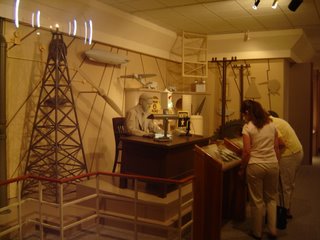 More importantly, Hoover helped set the rules and regulations for the cutting edge of mass communication systems: like terrestrial radio.
More importantly, Hoover helped set the rules and regulations for the cutting edge of mass communication systems: like terrestrial radio. In 1928, Coolidge decided he would not run for another term. With Hoover being extremely popular, he was the clear candidate to run under the banner of the Republican party.
In 1928, Coolidge decided he would not run for another term. With Hoover being extremely popular, he was the clear candidate to run under the banner of the Republican party. Hoover would dominate New York Democrat Alfred E. Smith, the first Catholic to get a major party nomination. Being Catholic was a liability for Smith (it still is today), as opponents spread rumors that the Pope would run the country if he got elected.
Hoover would dominate New York Democrat Alfred E. Smith, the first Catholic to get a major party nomination. Being Catholic was a liability for Smith (it still is today), as opponents spread rumors that the Pope would run the country if he got elected. As a popular reformer and visionary, Hoover was elected to very high expectations. This telegram of congratulations came from Thomas Edison.
As a popular reformer and visionary, Hoover was elected to very high expectations. This telegram of congratulations came from Thomas Edison.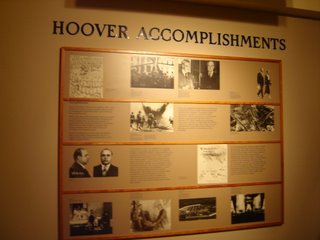 He was elected President of the United States to very high expectations. He practices a "Good Neighbor Policy" towards Latin America (a phrase made famous by FDR) and withdrew troops from Haiti and Nicaragua. He and former Secretary of State Henry Stimson negotiated a boarder dispute between Chile and Peru. He is also credited with signing the London Naval Treaty, reforming Federal courts, creating the Federal Farm Board and Veterans Administration, regulating stocks and securities, increasing acreage of national forests, and expanding the national park system.
He was elected President of the United States to very high expectations. He practices a "Good Neighbor Policy" towards Latin America (a phrase made famous by FDR) and withdrew troops from Haiti and Nicaragua. He and former Secretary of State Henry Stimson negotiated a boarder dispute between Chile and Peru. He is also credited with signing the London Naval Treaty, reforming Federal courts, creating the Federal Farm Board and Veterans Administration, regulating stocks and securities, increasing acreage of national forests, and expanding the national park system.On June 25, 1929, President Hoover signed the $165 million Boulder Canyon Project Act, which would become the Hoover Dam.
 Oh yeah, and there was a little thing called the Great Depression. A stock market crash on October 29, 1929 -- where $30 billion of wealth disappeared -- triggered a time period of pain and disaster for America. The library positions him as doing more in this regard than any previous president, "paving the way for the anti-depression New Deal measures".
Oh yeah, and there was a little thing called the Great Depression. A stock market crash on October 29, 1929 -- where $30 billion of wealth disappeared -- triggered a time period of pain and disaster for America. The library positions him as doing more in this regard than any previous president, "paving the way for the anti-depression New Deal measures".Between 1929 and 1933, America's economic output was cut in half. Nearly six thousand banks went under, taking $3 billion of uninsured dollars with them. The bond market suffered when the real estate boom went bust. The worst drought in U.S. history took place in an area the size of Europe. In 1932, unemployment reached over twelve million people, 23.6% of the population.
A sign at the museum says that Hoover's greatest failure was his "failure to dramatize himself," which seems odd in the context of a 23.6% unemployment rate. Now I know who President Hoover was...he was the guy in charge of a disaster.
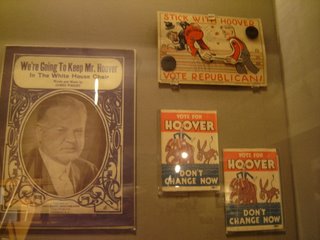 Hoover's efforts were not enough. Hoover would be demolished by Franklin D. Roosevelt in the 1932 election, losing all but six states (including Iowa) and bringing in a Democratic majority that would last more than 50 years. Hoover was shocked and stunned by the loss.
Hoover's efforts were not enough. Hoover would be demolished by Franklin D. Roosevelt in the 1932 election, losing all but six states (including Iowa) and bringing in a Democratic majority that would last more than 50 years. Hoover was shocked and stunned by the loss. In his final weeks as president, a banking crisis took place. Hoover had a suggested course of action, but wanted the president-elect to join with him on the solution. FDR balked on the idea, and Hoover's presidency ended in another failure. Shortly after assuming office, Roosevelt enacted the exact same policy that Hoover had suggested.
In his final weeks as president, a banking crisis took place. Hoover had a suggested course of action, but wanted the president-elect to join with him on the solution. FDR balked on the idea, and Hoover's presidency ended in another failure. Shortly after assuming office, Roosevelt enacted the exact same policy that Hoover had suggested. He had to repair his image in the years after his presidency, but eventually would serve as an elder statesman, and is credited (by the museum) as defining the modern post-presidency. He would do things like meet with Hitler and try to convince America not to get into World War II. Man, even after he left office he seemed on the wrong side of history. Why would the museum put up a photo with him and Hitler? Are they trying to get us to hate the guy?
He had to repair his image in the years after his presidency, but eventually would serve as an elder statesman, and is credited (by the museum) as defining the modern post-presidency. He would do things like meet with Hitler and try to convince America not to get into World War II. Man, even after he left office he seemed on the wrong side of history. Why would the museum put up a photo with him and Hitler? Are they trying to get us to hate the guy? After his wife's death, Hoover would move to New York and open up an office.
After his wife's death, Hoover would move to New York and open up an office. Here is a replica of his Manhattan office. It was at this point that I realized that there would be no replica of the Oval Office, a staple of the Presidential library system. Man, Hoover must have been bitter about his experience.
Here is a replica of his Manhattan office. It was at this point that I realized that there would be no replica of the Oval Office, a staple of the Presidential library system. Man, Hoover must have been bitter about his experience. A piece of the Berlin Wall is on display. Hoover would not see the end of the Cold War, as he would die on October 20, 1964.
A piece of the Berlin Wall is on display. Hoover would not see the end of the Cold War, as he would die on October 20, 1964. The museum had a temporary exhibit on the 1960s. It consisted mostly of photos, clothes, and music from the decade.
The museum had a temporary exhibit on the 1960s. It consisted mostly of photos, clothes, and music from the decade.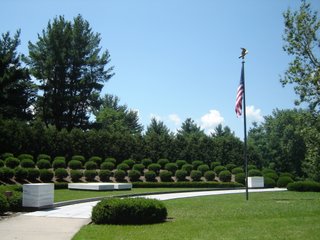 The grounds have other sites, like a schoolhouse and his birthplace.
The grounds have other sites, like a schoolhouse and his birthplace. But the site to see is the burial site of Hoover and his wife. It was simple and appropriate for a humble man who did his best.
But the site to see is the burial site of Hoover and his wife. It was simple and appropriate for a humble man who did his best.This is probably the most depressing of Presidential libraries, far surpassing the apologetic Jimmy Carter library in this regard. Hoover's legacy is not a good one, and seemed on the wrong side of history at every turn while president. He did seem to be a nice guy however, for whatever that is worth. But if we are truly to understand history, we must focus on our country's hard times, as it puts everything we have today in perspective.
In light of that, the trek to the Hoover library was well worth it.

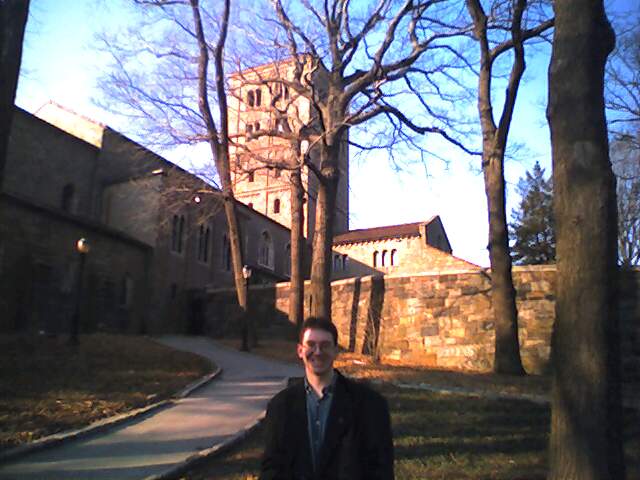

0 Comments:
Post a Comment
|<< Home